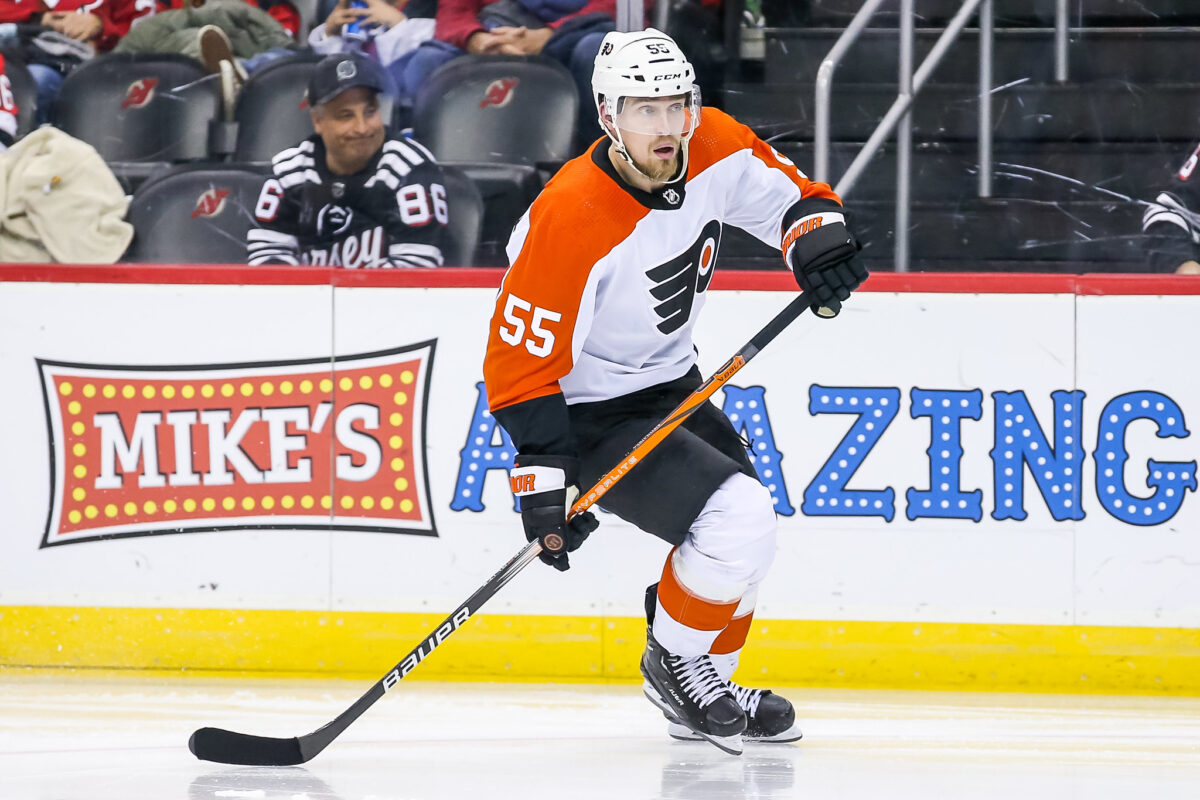Though the Philadelphia Flyers have started to find their footing with two wins in their last three games, they are 3-6-1 and hold the third-worst record in the NHL. The Orange and Black have a duty to build a competent roster for 19-year-old franchise cornerstone, Matvei Michkov, to compete with. Because of this, trading veteran roster players should always be in play.
Related: Flyers’ Samuel Ersson Stands Tall in 2-0 Win vs. Bruins
One of the few players on the Flyers who has performed higher than expectations is Rasmus Ristolainen. His name still gives many hockey fans pause due to his long-time struggles with the Buffalo Sabres, but he has turned it around in Philadelphia. Once trade season begins, that’ll come with a cost—what might that be?
Ristolainen Is Changing His Public Image
Don’t get it twisted—Ristolainen will never be the anchor of a defense like he was drafted to be at eighth overall back in 2013. However, we have to understand where he started from.
Size (6-foot-4, 219 pounds) was the main factor that made it so Ristolainen got top-pairing ice time with the endlessly rebuilding Sabres, but he probably didn’t deserve it. In a system that couldn’t maximize his potential, he was dealt to a Flyers team desperately lacking right-handed defensemen. Buffalo got a pretty sweet haul despite him being one of the worst players in analytics at the time: a 2021 first-round pick (Isak Rosen), a 2023 second-round pick (Anton Wahlberg), and Robert Hagg.
The trade from Philadelphia’s perspective mostly came with backlash, serving as one of the reasons then-general manager (GM) Chuck Fletcher was let go in March 2023. Since the 30-year-old defender was acquired, though, he has started to show signs of being a good hockey player.

The 2021-22 campaign wasn’t a great one for the right-shot Finn, but his next two were fairly good. That’s probably not much of a coincidence, as the defensively-oriented Brad Shaw was brought in as the team’s associate coach before the 2022-23 season along with head coach John Tortorella. Ristolainen’s usage shrunk, but he started to sacrifice fewer scoring chances and be more stable on the back end. While not exempt from making the occasional bad read (he still has issues with this), Ristolainen was playing the best hockey of his career. This season, he has only gotten better.
Among the 101 defensemen with 150 minutes of ice time in 2024-25, he is first in expected goals against per 60 minutes at even strength (1.74). Ristolainen has become somewhat of a low-event specialist under Shaw and Tortorella, but it has gotten results. So, why would the Flyers want to trade him?
The Benefits of Trading Ristolainen
The Flyers have a few goals this season, but none of them exactly involve winning the Stanley Cup. The key is to gain something of value, whether it be a top draft pick, playoff experience for their young players, or seeing those youngsters take the next step in their careers. Another couple of things that fall under the “gain something of value” umbrella? Freeing up money and acquiring futures.
With a $5.1 million cap hit through the 2026-27 campaign, Ristolainen is expendable. He is quite easily the team’s best right-handed defender, but the Flyers are already not winning and can use the extra money for a short-term replacement in free agency if they want to compete next season, anyway. With a couple of promising right-shot defenders in the pipeline (Oliver Bonk, Spencer Gill) and the raw but talented Jamie Drysdale on the current roster, room will need to be made.
Related: Philadelphia Flyers 2024-25 Prospect Pyramid
Just based on speculation, Ristolainen’s value is at an all-time high. His cap hit is rich for a rotating second- and third-pairing player, but getting anything like the Flyers gave up is a win. Not only does it improve their prospect pool that could use some bigger names on it, but it allows for financial freedom.
Estimating the Price of Ristolainen
So, what kind of return could be in store for Philadelphia regarding Ristolainen? Let’s speculate.
As mentioned, $5.1 million is a big commitment for one season, let alone three of them. Because of this, it’s fair to assume the Flyers will need to retain some of his contract. If they can stomach that sacrifice, their return will be maximized.
Before this season, a first-round pick probably wasn’t on the table for any kind of move. But it might be now. Right-handed defenders don’t exactly grow on trees, and especially not the physical kind. Teams value this and the ability to hunker down and prevent high-danger looks for the opposition when the playoffs come around.
There’s a running gag about what Ristolainen could look like if he makes the postseason someday, as it was one of the big reasons Fletcher went and got him. Size has been seen as an important trait for winning championships for decades now, so this makes sense in theory. The problem is that, in his 723-game career, he hasn’t even sniffed the first round—a perceived attribute has yet to be seen. Some GMs out there could see the same advantage in trading for him rather than one of the other players on the market. Thus, I believe a day-one draft pick could be in play here (think something similar to the Sean Walker deal).
Related: Grading the Avalanche’s Trade for Sean Walker
There are no guarantees the Flyers even want to part ways with Ristolainen. In a landscape with defensemen that have mostly regressed, it’s easy to see why there might be hesitation on not just getting rid of him, but eating some salary in addition. However, if the Flyers want to position themselves to succeed in the future and not just the present, the next few months might be their time to pull the trigger.
